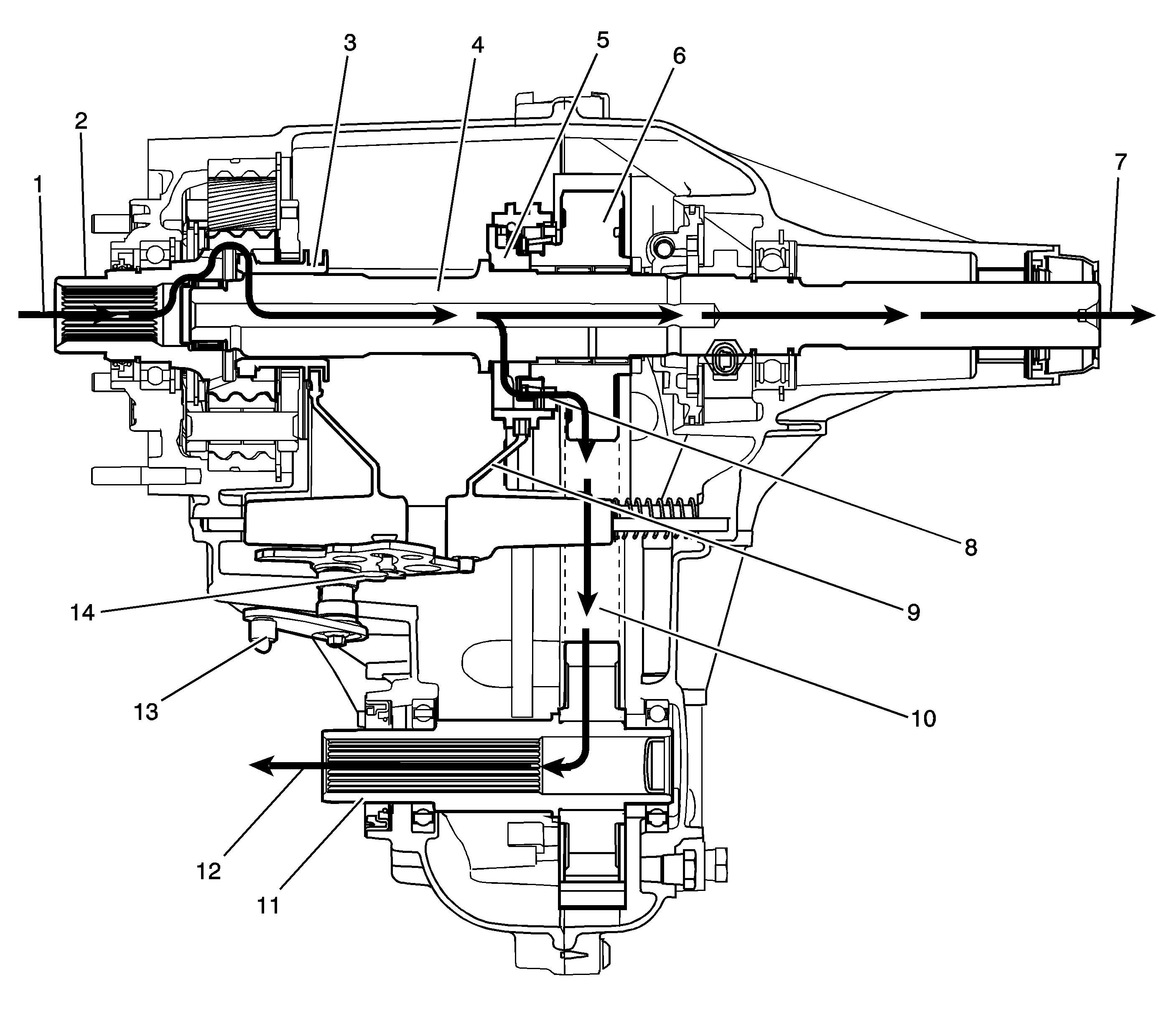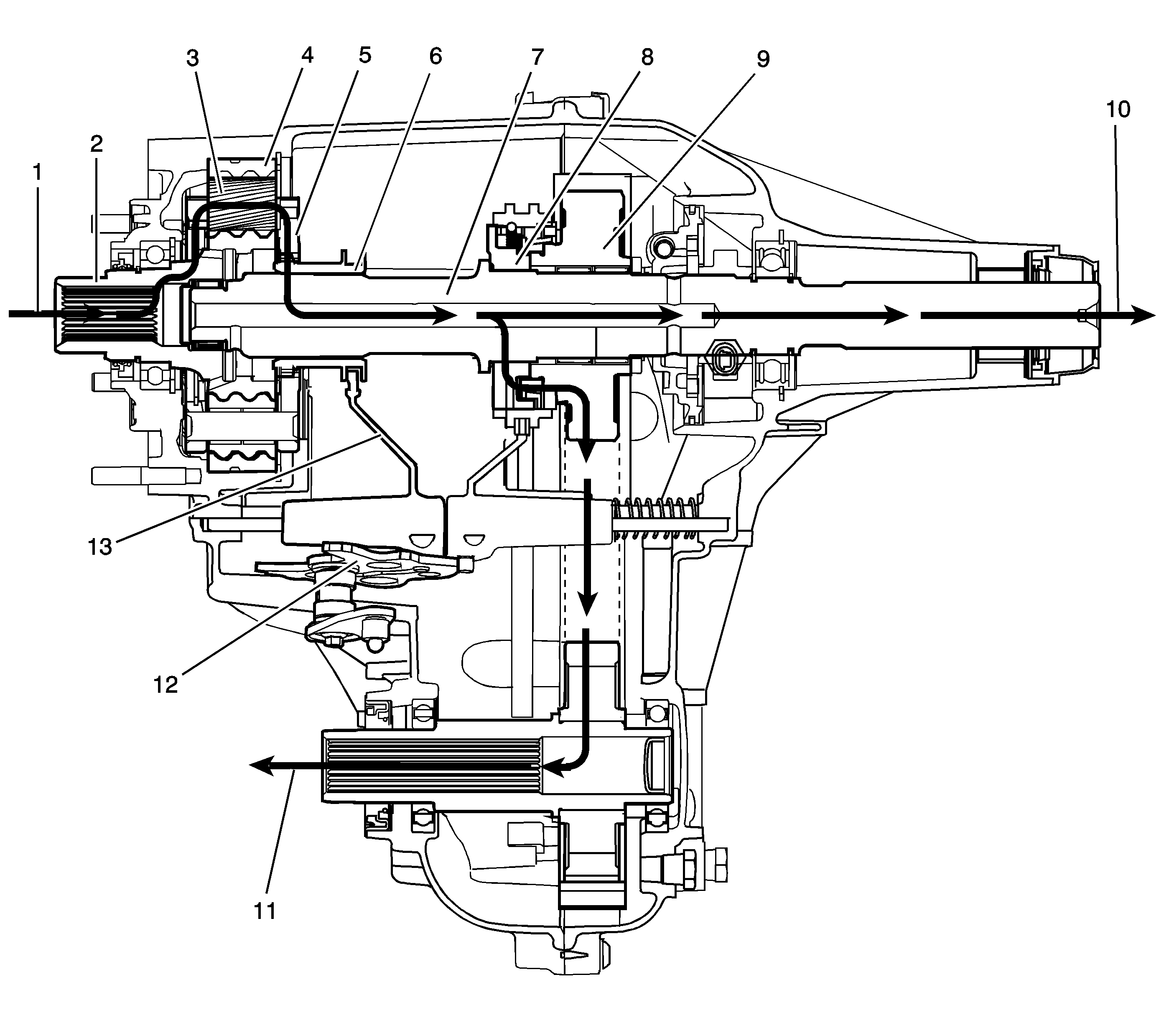The Magna Powertrain (MP) 1222/1225/1226, RPO NQG transfer case is a 2-speed, part-time with mode shift-on-the-fly capability. It has a chain driven front output shaft and an epicyclical low range planetary arrangement. The MP 1222/1225/1226 transfer case features a 4 position shift lever control located in the vehicle floor plan. As required, the operator can select 4HI position from 2HI on-the-fly, as described in the owners manual. A dash mounted 4WD lamp continues flashing during shifting, until all criteria have been met and the new mode/range position has been reached. Once the new mode/range position is fully engaged and the front axle disconnect locks in, the dash light 4WD indicator lamp remains ON constantly. Range shifting functions similarly, although it should be limited to speeds 5 km/h (3 mph) or less.
The 4 manual mode, or range gear positions, of the MP 1222/1225/1226 transfer case are:
| • | 2HI - 2 wheel drive high range |
| • | 4HI - 4 wheel drive high range, part-time |
| • | 4LO - 4 wheel drive low range, 2.68:1 gear ratio reduction |
| • | N - NEUTRAL, 4 wheel |
When the ignition switch is placed in the run position and the 4WD shift lever is in the 4WD position, the transfer case switch closes, supplying a ground to the axle actuator control circuit. With the ground applied, the logic of the front axle actuator actuates a DC motor to engage the front axle and supply voltage to the axle switch signal circuit. The axle switch signal circuit notifies the engine control module (ECM) and the Anti-Lock Brake System that the vehicle is in the 4WD mode. The 4WD indicator is commanded on via a GM LAN serial data signal from the ECM. When the 4WD shift lever is in the 4WD low range position, the transfer case switch closes and supplies a ground on the 4WD low signal circuit. This informs the ECM that the vehicle transfer case is in low range. When the vehicle is in low range, the transmission control module (TCM) changes the shift pattern of the automatic transmission.
During normal driving situations, the transfer case can operate in the 2WD mode. The driver may choose to select any of the mode/range gear positions while driving the vehicle. However, the transfer case should not be shifted into or out of 4LO unless the following criteria have been met:
| • | The transmission is in NEUTRAL. |
| • | The vehicle speed is less than 5 km/h (3 mph). |
This transfer case also has a NEUTRAL position. A shift to the NEUTRAL position allows the vehicle to be towed without rotating the transmission output shaft. In the NEUTRAL position, the rear propeller shaft rotates the transfer case rear output shaft, in turn rotating the oil pump, providing constant lubrication during towing. Note, this NEUTRAL position is a 4WD NEUTRAL, meaning the front and rear outputs of the transfer case are engaged as though in 4HI. With a disconnecting front axle, there is no power flow to the front wheels, allowing towing with the front wheels off the ground or flat towing without driveline binding. Again, the transfer case should not be shifted into or out of NEUTRAL unless the following criteria have been met:
| • | The transmission is in NEUTRAL. |
| • | The vehicle speed is less than 5 km/h (3 mph). |
The NQG transfer case is available in 3 variations, depending on the engine and transmission configurations. The variations allow the transfer case to handle different torque loads. When servicing the transfer case it is important to understand which variation is being serviced because of the difference in parts.
Model | Transmission | Input Shaft | Output Shaft | Chain Size | Chain Series | Hi/Low Planetary | Application |
|---|---|---|---|---|---|---|---|
MP 1222 Light Duty (LD) | M30 - 4L60-E | 27T Spline | 32T Spline | 7/16 X 1.25 in | 9600 Series Rocker Pin Chain | 3 Pinion | K1 |
MP 1225 Heavy Duty (HD) | MYD - 6L90 | 29T Spline | 31T Spline | 7/16 X 1.5 in | 9600 Series Rocker Pin Chain | 5 Pinion | K2 |
MP 1226 Super Heavy Duty (SHD) | MYD - 6L90 MW7 - Allison | 29T Spline | 31T Spline | 7/16 X 1.5 in | 2300 Series Round Pin Chain | 5 Pinion | K2, K3 |
All Canadian MP1225 Transfer Cases will be equipped with the 2300 series round pin chain.
Additional differences in these models are listed below:
MP1222
| • | The input shaft seal is a dual lip seal used with wet cavity adapters. |
| • | The input shaft pilot bearing assembly is smaller to accommodate the smaller rear output shaft, the outer diameter measures 38.1 mm (1.5 in). |
| • | The high/low clutch has bias pointing engagement teeth, the leading edge of the teeth are not symmetric. |
| • | The rear output shaft is smaller. |
| • | The front output shaft drive sprocket is 31.75 mm (1.25 in) wide. |
| • | The front output shaft driven sprocket is 31.75 mm (1.25 in) wide. |
| • | The rear output shaft rear bearing retaining rings are smaller, the outer diameter of the ring groove at the rear output shaft measures 37.5 mm (1.476 in) |
| • | The rear output shaft rear bearing assembly is smaller, the inner diameter measures 40 mm (1.575 in). |
| • | The rear output shaft seal is smaller, the inner lip diameter measures 46.2 mm (1.819 in). |
| • | The rear output shaft bushing is smaller, the inner diameter measures 48 mm (1.890 in). |
| • | The rear case half has smaller bores to accommodate the rear output shaft seal and the rear output shaft bushing. |
MP 1225
The input shaft seal is a single lip seal used only with dry cavity adapters.
MP 1226
The input shaft seal is a dual lip seal used specifically for the MW7 which has a wet cavity adapter, these seals are also used for the MYD in order to retain a common part number for this model.
MP 1225/1226
| • | The input shaft pilot bearing assembly is larger to accommodate the larger rear output shaft, the outer diameter measures 41.275 mm (1.625 in) |
| • | An input shaft pilot bearing retaining ring is used. |
| • | The high/low clutch has neutral pointing engagement teeth, the leading edge of the teeth are symmetric. |
| • | The rear output shaft is larger. |
| • | The front output shaft drive sprocket is 38.1 mm (1.5 in) wide. |
| • | The front output shaft driven sprocket is 38.1 mm (1.5 in) wide. |
| • | The rear output shaft rear bearing retaining rings are larger, the outer diameter of the ring groove at the rear output shaft measures 38.5 mm (1.516 in). |
| • | The rear output shaft rear bearing assembly is larger, the inner diameter measures 41 mm (1.614 in). |
| • | The rear output shaft seal is larger, the inner lip diameter measures 54.2 mm (2.134 in). |
| • | The rear output shaft bushing is larger, the inner diameter measures 56.08 mm (2.208 in). |
| • | The rear case half has larger bores to accommodate the rear output shaft seal and the rear output shaft bushing. |
2WD Mode Power Flow

The transfer case is shifted by a remote mounted shift lever, which is connected by linkage to the shift lever (9) on the shift detent lever shaft. The shift detent lever shaft rotates the cam shaped shift detent lever assembly (10) and moves the high/low range shift fork (11) or the 2/4 wheel drive mode shift fork (8). Depending on the selected mode or range, the shift forks move either the high/low clutch (4) for the high/low range planetary assembly (3) or the synchronizer sleeve (6) for the 2/4 wheel drive mode. In the 2WD mode, the engine power from the transmission (1) is delivered to the input shaft (2). The engagement teeth on the inside of the input shaft (2) are engaged to the outer teeth on the high/low clutch (4). The high/low clutch (4) is slipped splined to the rear output shaft (5). The engine power flows from the high/low clutch (4) to the rear output shaft (5) and is delivered to the rear propeller shaft (7).
4HI Mode Power Flow

In the 4HI mode, the engine power from the transmission (1) is delivered to the input shaft (2). The engagement teeth on the inside of the input shaft (2) are engaged to the outer teeth on the high/low clutch (3). The high/low clutch (3) is slipped splined to the rear output shaft (4). During a shift mode from 2HI to 4HI the cam profile on the shift detent lever assembly (14) pushes the 2/4 wheel drive mode shift fork (9) and the synchronizer sleeve. The sleeve, engaging the synchronizer (8) equalizes the front propeller shaft (12) and rear propeller shaft (7) speeds. Then the sleeve engages to the drive sprocket (6). The engine power flow for driving the front propeller shaft (12), now travels from the rear output shaft (4) to the synchronizer hub (5), which is splined to the rear output shaft (4). The power flows from the synchronizer hub (5) to the sleeve and then to the drive sprocket (6). The power flow is transmitted by a chain (10) to the driven sprocket on the front output shaft (11) and to the front propeller shaft (12). The front and rear propeller shafts are being driven at equal RPM, therefore giving a four wheel drive mode. This mode should only be used for extra traction. Using this mode on dry pavement causes tire scuffing when turning.
4LO Mode Power Flow

During range shift request to 4LO, a separate cam profile on the same shift detent lever assembly (12) moves the high/low shift fork (13). The high/low shift fork (13) moves the high/low clutch (6) rearward. The high/low clutch (6) outer teeth disengage from the input shaft (2) high-speed teeth. The high/low clutch (6) outer teeth then engage in the high/low planetary carrier teeth (5). The power flow is now from the transmission (1), to the planetary teeth on the input shaft (2), to the planetary gears (3) in the high/low planetary carrier assembly (5). Rotating the planetary gears (3), which are engaged in the high/low internal gear (4), rotates the high/low planetary carrier assembly (5). The high/low planetary carrier assembly (5) delivers the power to the high/low clutch (6). The high/low clutch (6) then drives the rear output shaft (7), providing a 2.68:1 gear ratio reduction to the rear output shaft (7). The sleeve is still engaged to drive the drive sprocket (9), as in the 4HI position, providing the engine power to the rear propeller shaft (10) and to the front propeller shaft (11).
NEUTRAL Mode Power Flow
Shifting to the NEUTRAL position, the high/low clutch is centered between the input shaft and the high/low planetary carrier. The high/low clutch is not engaged with either the input shaft or the high/low planetary carrier teeth. The 2/4 wheel drive synchronizer is in the 4HI mode position.
